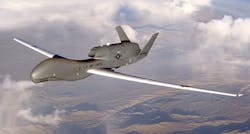Pentagon plans to spend $2.45 billion next year on UAVs for surveillance and attack
The Pentagon's proposed flying drone budget of $2.45 billion in fiscal 2015 is up 15.8 percent from this year's enacted UAV spending level of 2.1 billion, and is up 3 percent from what the Pentagon requested for this year, according to Pentagon budget documents.
The U.S. Department of Defense (DOD) released its proposed fiscal 2015 budget this past Tuesday. Federal fiscal year 2015 begins next October 1.
Military leaders propose spending $855.79 million next year on procurement and research for the Northrop Grumman RQ-4 Global Hawk high-altitude long-endurance UAV and on the MQ-4 Triton, Northrop Grumman's maritime patrol version of the Global Hawk.
Related: Air Force looks to Northrop Grumman for Global Hawk UAV maintenance through late 2014
U.S. Air Force RQ-4, Navy MQ-4C, and NATO Alliance Ground Surveillance (AGS) UAVs provide high altitude long endurance intelligence, surveillance, and reconnaissance capabilities.
The RQ-4 Block 30 includes a multi-intelligence suite for imagery and signals intelligence collection and the Block 40 includes multi-platform radar technology for synthetic aperture radar (SAR) imaging and moving target detection.
The final two Block 40 USAF RQ-4s will be delivered this year. The Navy MQ-4C Triton provides persistent maritime surveillance with systems such as inverse SAR, electro-optical/infra-red full motion video, electronic support measures, automatic identification system, a basic communications relay capability, and Link-16.
Next year Air Force officials want to develop the Block 30 and Block 40 Global Hawk ground stations, and multi-platform radar technology insertion programs. The Navy plans MQ-4C Triton engineering and manufacturing development and advanced procurement for four planned low rate initial production systems in 2016.
The UAV has sensors to include day/night full motion video, signals intelligence, and synthetic aperture radar, as well as avionics, data links, and weapons. The Reaper also has a ground control segment for launch and recovery and mission control element with embedded line-of-sight and beyond-line-of-sight communications.
Related: Navy edges closer to choosing a contractor to build next-generation carrier-based UAV
For 2015 DOD officials propose to buy 12 Reaper aircraft and 12 fixed ground control stations, as well as modify MQ-9s to the extended-range configuration. Contractor: General Atomics–Aeronautical Systems Inc. in San Diego builds the Reaper.
MQ-1 Predator spending next year is proposed at $270.1 million. This includes spending for the MQ-1C Gray Eagle UAV. The U.S. Air Force Predator and Army Gray Eagle UAVs have multi-spectral targeting systems infrared sensors, laser designators, and infrared illuminator for real-time full motion video.
Predator and Gray Eagle UAVs also have weapons; data links; and ground control stations with communications equipment providing line-of-sight and beyond-line-of-sight control. Both systems single-engine, propeller-driven UAVs.
The Predator and Gray Eagle UAVs operate over-the-horizon at medium altitude for long endurance and provide real-time intelligence, surveillance, reconnaissance, and target acquisition, and strike capability on time-sensitive targets.
The Army MQ-1C Gray Eagle also adds synthetic aperture radar ground moving target indicator, a communications relay capability, a heavy fuel engine, tactical common data link, and weapons.
Next year the Air Force plans to field Predator airframe modifications and ground stations. For Gray Eagle, the Army continues development and integration of the universal ground control station, a ground based sense-and-avoid system, and a signals intelligence capability; and procures 19 Gray Eagle aircraft.
Related: U.S. Army orders AeroVironment RQ-11B Raven small unmanned aircraft systems, new payload
Proposed spending for the Unmanned Carrier-Launched Airborne Surveillance and Strike (UCLASS) in 2015 is $403 million. UCLASS is the next step in the Navy’s integration of UAVs onto aircraft carriers. When fielded, UCLASS will provide a persistent, aircraft carrier-based intelligence, surveillance, reconnaissance, targeting, and strike capability.
UCLASS has a control system and connectivity segment, a carrier segment, and an air segment. The system will maximize use of existing technology to launch and control the air vehicle, transfer data, and support persistent surveillance and precision strike operations.
Later this year Navy officials will announce the air segment draft request for proposal for UCLASS technology development. A contract award is expected in fall 2015.
Related: Navy buys one Insitu RQ-21A Blackjack UAV in preparation for ramping-up production
The RQ-7, RQ-11, and RQ-21 UAVs provide organic reconnaissance, surveillance, target acquisition. The Army/Marine Corps RQ-7 Shadow and Marine Corps/Navy RQ-21 Blackjack UAVs provide the tactical maneuver commander near real-time surveillance and force protection during day/night and limited adverse weather conditions.
The multi-sensor RQ-11 Raven provides an over-the-hill rucksack-portable, day/night, limited adverse weather, remotely-operated capability that supports combat battalions and below, and selected combat support units.
Related: General Atomics wins $110.3 million Army contract to maintain MQ-1C Gray Eagle UAVs
The multi-sensor RQ-21 Blackjack is runway independent, requiring minimal space for takeoff and recovery from an unimproved expeditionary/urban environment, as well as from the decks of Navy ships.
Proposed funding would pay for three systems -- each one consisting of five aircraft, two ground control stations, payloads, launch and recovery system, and ground support. Funding also would pay for testing and contractor logistics support for the RQ-21 Blackjack. The RQ-7 Shadow builder is AAI Corp. in Hunt Valley, Md., and building the RQ-11 Raven is AeroVironment in Monrovia, Calif.
Proposed military spending for UAVs next year includes new purchases and systems upgrades for the aircraft themselves, sensor and weapons payloads, control systems, and basic research and development.
Other proposed UAV spending for fiscal 2015 includes $35.9 million for research and development on a future unmanned combat aerial vehicle (UCAV) prototype; and $2 million for miscellaneous UAV sensor and weapons payloads.




